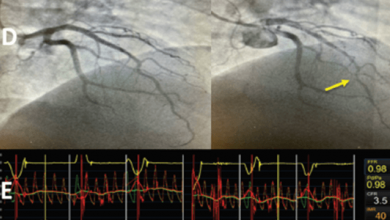Search results
OCT in MINOCA
Author(s):
Grigoris V Karamasis
,
Iosif Xenogiannis
,
Charalampos Varlamos
,
et al
Added:
1 year ago
Article
Author(s):
Giuseppe Sangiorgi
,
Fabrizio Clementi
,
Clarissa Cola
Added:
3 years ago
Several independent lines of clinical evidence have shown that critical stenoses cause only a fraction of ACS. Rather, ruptures of a thin fibrous cap covering a large lipid-rich necrotic or superficial intimal erosion frequently trigger acute coronary thromboses at sites of non-critical narrowing of coronary arteries. This shift in thinking has fostered the notion of the so-called 'vulnerable' or…
View more
Author(s):
Sean Fitzgerald
,
Maria Rubini Gimenez
,
Abdelhakim Allali
,
et al
Added:
1 year ago
Author(s):
Eunice NC Onwordi
,
Amr Gamal
,
Azfar Zaman
Added:
3 years ago
Acute coronary syndromes (ACS) are a major cause of morbidity and mortality. Despite the use of optimal medical therapy and revascularisation there remains a significant risk of vascular events. Registry data indicates a persistent risk even in patients who are event free in the first year following ACS, with as many as 1 in 5 patients suffering a vascular event in the subsequent 3 years.1
The…
View more
Author(s):
Robert Sykes
,
Daniel Doherty
,
Kenneth Mangion
,
et al
Added:
2 years ago
Author(s):
Fausto Castriota
,
Armando Liso
,
Giancarlo Biamino
,
et al
Added:
3 years ago
Carotid angioplasty and stenting (CAS) is becoming a frequent therapeutic strategy for approaching severe carotid obstructive disease and is now widely accepted as a less invasive technique that provides an attractive alternative for many patients, particularly those with significant co-morbidities.1–6 From a technical standpoint, the continuous evolution of carotid stent design increases the…
View more
Author(s):
Sudheer Koganti
,
Tushar Kotecha
,
Roby D Rakhit
Added:
3 years ago
Intracoronary imaging is able to aid the interventional cardiologist in the characterisation of atherosclerotic plaque morphology, in optimising stent sizing, and in minimising the complications associated with percutaneous coronary intervention (PCI). Intravascular ultrasound (IVUS) and optical coherence tomography (OCT) are commonly used methods, while newer spectroscopic methods are under…
View more
Author(s):
Carlotta Sorini Dini
,
Giulia Nardi
,
Francesca Ristalli
,
et al
Added:
3 years ago
In the 18th century, Edward Jenner and Caleb Hillier Parry, two British physicians, independently noticed that coronary ossification was often present in patients dying of ‘syncope anginosa’.1 Coronary angiography opened the possibility of expanding these observations to living patients and offered revascularisation options. During surgery, it was often possible to modify the position of the…
View more
Endovascular Aneurysm Repair
Author(s):
Alexandra A MacLean
,
Barry T Katzen
Added:
3 years ago
Article
Author(s):
Deepak Natarajan
Added:
3 years ago
Primary percutaneous coronary intervention (PCI) is the treatment of choice in the management of acute ST-segment elevation myocardial infarction (STEMI). It has been constantly observed that, despite restoring good epicardial flow with PCI, myocardial perfusion at the cellular level remains impaired in nearly 50 % of STEMI patients. This led to the development of a new class of antiplatelet…
View more















